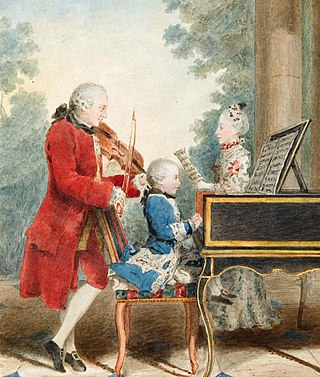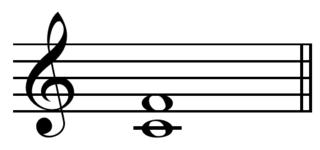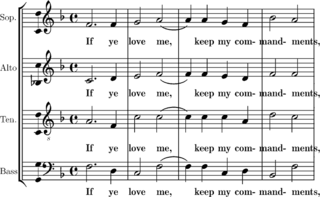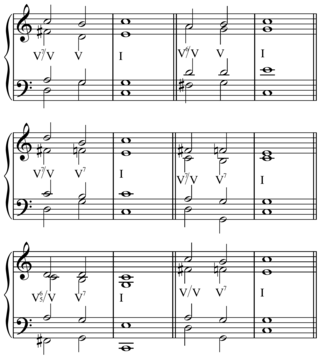
The Classical period was an era of classical music between roughly 1750 and 1820.

In music, counterpoint is the relationship between two or more musical lines which are harmonically interdependent yet independent in rhythm and melodic contour. It has been most commonly identified in the European classical tradition, strongly developing during the Renaissance and in much of the common practice period, especially in the Baroque period. The term originates from the Latin punctus contra punctum meaning "point against point", i.e. "note against note".

Medieval music encompasses the sacred and secular music of Western Europe during the Middle Ages, from approximately the 6th to 15th centuries. It is the first and longest major era of Western classical music and followed by the Renaissance music; the two eras comprise what musicologists generally term as early music, preceding the common practice period. Following the traditional division of the Middle Ages, medieval music can be divided into Early (500–1150), High (1000–1300), and Late (1300–1400) medieval music.

Polyphony is a type of musical texture consisting of two or more simultaneous lines of independent melody, as opposed to a musical texture with just one voice, monophony, or a texture with one dominant melodic voice accompanied by chords, homophony.

A melody, also tune, voice or line, is a linear succession of musical tones that the listener perceives as a single entity. In its most literal sense, a melody is a combination of pitch and rhythm, while more figuratively, the term can include other musical elements such as tonal color. It is the foreground to the background accompaniment. A line or part need not be a foreground melody.

In music, harmony is the process by which individual sounds are joined or composed into whole units or compositions. Often, the term harmony refers to simultaneously occurring frequencies, pitches, or chords. However, harmony is generally understood to involve both vertical harmony (chords) and horizontal harmony (melody).

Orchestration is the study or practice of writing music for an orchestra or of adapting music composed for another medium for an orchestra. Also called "instrumentation", orchestration is the assignment of different instruments to play the different parts of a musical work. For example, a work for solo piano could be adapted and orchestrated so that an orchestra could perform the piece, or a concert band piece could be orchestrated for a symphony orchestra.

A fourth is a musical interval encompassing four staff positions in the music notation of Western culture, and a perfect fourth is the fourth spanning five semitones. For example, the ascending interval from C to the next F is a perfect fourth, because the note F is the fifth semitone above C, and there are four staff positions between C and F. Diminished and augmented fourths span the same number of staff positions, but consist of a different number of semitones.

In music, monophony is the simplest of musical textures, consisting of a melody, typically sung by a single singer or played by a single instrument player without accompanying harmony or chords. Many folk songs and traditional songs are monophonic. A melody is also considered to be monophonic if a group of singers sings the same melody together at the unison or with the same melody notes duplicated at the octave. If an entire melody is played by two or more instruments or sung by a choir with a fixed interval, such as a perfect fifth, it is also said to be monophony. The musical texture of a song or musical piece is determined by assessing whether varying components are used, such as an accompaniment part or polyphonic melody lines.

In music, unison is two or more musical parts that sound either the same pitch or pitches separated by intervals of one or more octaves, usually at the same time. Rhythmic unison is another term for homorhythm.
In music, texture is how the tempo, melodic, and harmonic materials are combined in a musical composition, determining the overall quality of the sound in a piece. The texture is often described in regard to the density, or thickness, and range, or width, between lowest and highest pitches, in relative terms as well as more specifically distinguished according to the number of voices, or parts, and the relationship between these voices. For example, a thick texture contains many 'layers' of instruments. One of these layers could be a string section or another brass. The thickness also is changed by the amount and the richness of the instruments playing the piece. The thickness varies from light to thick. A piece's texture may be changed by the number and character of parts playing at once, the timbre of the instruments or voices playing these parts and the harmony, tempo, and rhythms used. The types categorized by number and relationship of parts are analyzed and determined through the labeling of primary textural elements: primary melody (PM), secondary melody (SM), parallel supporting melody (PSM), static support (SS), harmonic support (HS), rhythmic support (RS), and harmonic and rhythmic support (HRS).

In music, consonance and dissonance are categorizations of simultaneous or successive sounds. Within the Western tradition, some listeners associate consonance with sweetness, pleasantness, and acceptability, and dissonance with harshness, unpleasantness, or unacceptability, although there is broad acknowledgement that this depends also on familiarity and musical expertise. The terms form a structural dichotomy in which they define each other by mutual exclusion: a consonance is what is not dissonant, and a dissonance is what is not consonant. However, a finer consideration shows that the distinction forms a gradation, from the most consonant to the most dissonant. In casual discourse, as German composer and music theorist Paul Hindemith stressed, "The two concepts have never been completely explained, and for a thousand years the definitions have varied". The term sonance has been proposed to encompass or refer indistinctly to the terms consonance and dissonance.

In music, homophony is a texture in which a primary part is supported by one or more additional strands that provide the harmony. One melody predominates while the other parts play either single notes or an elaborate accompaniment. This differentiation of roles contrasts with equal-voice polyphony and monophony. Historically, homophony and its differentiated roles for parts emerged in tandem with tonality, which gave distinct harmonic functions to the soprano, bass and inner voices.

In music, imitation is the repetition of a melody in a polyphonic texture shortly after its first appearance in a different voice. The melody may vary through transposition, inversion, or otherwise, but retain its original character. The intervals and rhythms of an imitation may be exact or modified; imitation occurs at varying distances relative to the first occurrence, and phrases may begin with voices in imitation before they freely go their own ways.

In music, a step, or conjunct motion, is the difference in pitch between two consecutive notes of a musical scale. In other words, it is the interval between two consecutive scale degrees. Any larger interval is called a skip, or disjunct motion.

In music theory, voicing refers to two closely related concepts:
- How a musician or group distributes, or spaces, notes and chords on one or more instruments
- The simultaneous vertical placement of notes in relation to each other; this relates to the concepts of spacing and doubling
In music, especially Schenkerian analysis, a voice exchange is the repetition of a contrapuntal passage with the voices' parts exchanged; for instance, the melody of one part appears in a second part and vice versa. It differs from invertible counterpoint in that there is no octave displacement; therefore it always involves some voice crossing. If scored for equal instruments or voices, it may be indistinguishable from a repeat, although because a repeat does not appear in any of the parts, it may make the music more interesting for the musicians. It is a characteristic feature of rounds, although not usually called such.

A part generally refers to a single strand or melody or harmony of music within a larger ensemble or a polyphonic musical composition. There are several senses in which the word is often used:
Traditional sub-Saharan African harmony is a music theory of harmony in sub-Saharan African music based on the principles of homophonic parallelism, homophonic polyphony, counter-melody and ostinato-variation. Polyphony is common in African music and heterophony is a common technique as well. Although these principles of traditional African music are of Pan-African validity, the degree to which they are used in one area over another varies. Specific techniques that used to generate harmony in Africa are the "span process", "pedal notes", "rhythmic harmony", "harmony by imitation", and "scalar clusters".
















